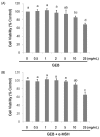Inhibitory effect of Gastrodia elata Blume extract on alpha-melanocyte stimulating hormone-induced melanogenesis in murine B16F10 melanoma
- PMID: 28584573
- PMCID: PMC5449373
- DOI: 10.4162/nrp.2017.11.3.173
Inhibitory effect of Gastrodia elata Blume extract on alpha-melanocyte stimulating hormone-induced melanogenesis in murine B16F10 melanoma
Abstract
Background/objectives: Gastrodia elata Blume (GEB), a traditional herbal medicine, has been used to treat a wide range of neurological disorders (e.g., paralysis and stroke) and skin problems (e.g., atopic dermatitis and eczema) in oriental medicine. This study was designed to investigate whether GEB extract inhibits melanogenesis activity in murine B16F10 melanoma.
Materials/method: Murine B16F10 cells were treated with 0-5 mg/mL of GEB extract or 400 µg/mL arbutin (a positive control) for 72 h after treatment with/without 200 nM alpha-melanocyte stimulating hormone (α-MSH) for 24 h. Melanin concentration, tyrosinase activity, mRNA levels, and protein expression of microphthalmia-associated transcription factor (MITF), tyrosinase, tyrosinase-related protein (Trp)1, and Trp2 were analyzed in α-MSH-untreated and α-MSH-treated B16F10 cells.
Results: Treatment with 200 nM α-MSH induced almost 2-fold melanin synthesis and tyrosinase activity along with increased mRNA levels and protein expression of MITF, tyrosinase, Trp1 and Trp2. Irrespective of α-MSH stimulation, GEB extract at doses of 0.5-5 mg/mL inhibited all these markers for skin whitening in a dose-dependent manner. While lower doses (0.5-1 mg/mL) of GEB extract generally had a tendency to decrease melanogenesis, tyrosinase activity, and mRNA levels and protein expression of MITF, tyrosinase, Trp1, and Trp2, higher doses (2-5 mg/mL) significantly inhibited all these markers in α-MSH-treated B16F10 cells in a dose-dependent manner. These inhibitory effects of the GEB extract at higher concentrations were similar to those of 400 µg/mL arbutin, a well-known depigmenting agent.
Conclusions: These results suggest that GEB displays dose-dependent inhibition of melanin synthesis through the suppression of tyrosinase activity as well as molecular levels of MITF, tyrosinase, Trp1, and Trp2 in murine B16F10 melanoma. Therefore, GEB may be an effective and natural skin-whitening agent for application in the cosmetic industry.
Keywords: Gastrodia elata; melanogenesis; tyrosinase.
Conflict of interest statement
CONFLICT OF INTEREST: The authors declare no potential conflicts of interests.
Figures





Similar articles
-
Inhibitory activity of soybean (Glycine max L. Merr.) Cell Culture Extract on tyrosinase activity and melanin formation in alpha-melanocyte stimulating Hormone-Induced B16-F10 melanoma cells.Mol Biol Rep. 2022 Aug;49(8):7827-7836. doi: 10.1007/s11033-022-07608-6. Epub 2022 Jun 22. Mol Biol Rep. 2022. PMID: 35733058
-
Unveiling the Potential of Ultrasonic-Assisted Ethanol Extract from Sargassum horneri in Inhibiting Tyrosinase Activity and Melanin Production in B16F10 Murine Melanocytes.Front Biosci (Landmark Ed). 2024 May 20;29(5):194. doi: 10.31083/j.fbl2905194. Front Biosci (Landmark Ed). 2024. PMID: 38812330
-
Diphlorethohydroxycarmalol inhibits melanogenesis via protein kinase A/cAMP response element-binding protein and extracellular signal-regulated kinase-mediated microphthalmia-associated transcription factor downregulation in α-melanocyte stimulating hormone-stimulated B16F10 melanoma cells and zebrafish.Cell Biochem Funct. 2021 Jun;39(4):546-554. doi: 10.1002/cbf.3620. Epub 2021 Jan 20. Cell Biochem Funct. 2021. PMID: 33474761
-
Gastrodia elata Blume: A review of its mechanisms and functions on cardiovascular systems.Fitoterapia. 2023 Jun;167:105511. doi: 10.1016/j.fitote.2023.105511. Epub 2023 Apr 17. Fitoterapia. 2023. PMID: 37075984 Review.
-
Molecular understanding of the therapeutic potential of melanin inhibiting natural products.RSC Med Chem. 2024 May 10;15(7):2226-2253. doi: 10.1039/d4md00224e. eCollection 2024 Jul 17. RSC Med Chem. 2024. PMID: 39026645 Free PMC article. Review.
Cited by
-
Traditional Asian Herbs in Skin Whitening: The Current Development and Limitations.Front Pharmacol. 2020 Jul 7;11:982. doi: 10.3389/fphar.2020.00982. eCollection 2020. Front Pharmacol. 2020. PMID: 32733239 Free PMC article. Review.
-
The Modulation of Melanogenesis in B16 Cells Upon Treatment with Plant Extracts and Isolated Plant Compounds.Molecules. 2022 Jul 7;27(14):4360. doi: 10.3390/molecules27144360. Molecules. 2022. PMID: 35889231 Free PMC article. Review.
-
Inhibitory Effect of Cuphea aequipetala Extracts on Murine B16F10 Melanoma In Vitro and In Vivo.Biomed Res Int. 2019 May 29;2019:8560527. doi: 10.1155/2019/8560527. eCollection 2019. Biomed Res Int. 2019. PMID: 31275985 Free PMC article.
-
Characterization of Caffeoylquinic Acids from Lepisorus thunbergianus and Their Melanogenesis Inhibitory Activity.ACS Omega. 2020 Nov 20;5(48):30946-30955. doi: 10.1021/acsomega.0c03752. eCollection 2020 Dec 8. ACS Omega. 2020. PMID: 33324802 Free PMC article.
-
Antiwrinkle and antimelanogenesis activity of the ethanol extracts of Lespedeza cuneata G. Don for development of the cosmeceutical ingredients.Food Sci Nutr. 2018 May 23;6(5):1307-1316. doi: 10.1002/fsn3.682. eCollection 2018 Jul. Food Sci Nutr. 2018. PMID: 30065832 Free PMC article.
References
-
- Chang T. Natural melanogenesis inhibitors acting through the down-regulation of tyrosinase activity. c. 2012;5:1661–1685.
-
- Arndt KA, Fitzpatrick TB. Topical use of hydroquinone as a depigmenting agent. JAMA. 1965;194:965–967. - PubMed
-
- Heilgemeir GP, Balda BR. Irreversible toxic depigmentation. Observations following use of hydroquinonemonobenzylether-containing skin bleaching preparations. MMW Munch Med Wochenschr. 1981;123:47–48. - PubMed
-
- Mishima Y, Hatta S, Ohyama Y, Inazu M. Induction of melanogenesis suppression: cellular pharmacology and mode of differential action. Pigment Cell Res. 1988;1:367–374. - PubMed
LinkOut - more resources
Full Text Sources
Other Literature Sources

